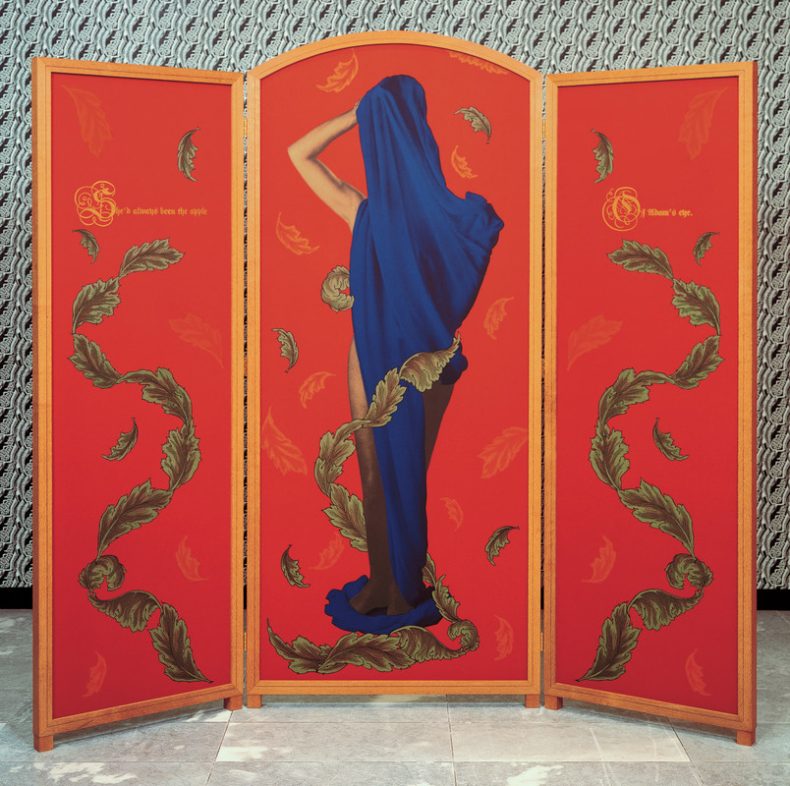As a child, I was drawn to folding screens and particularly enthusiastic about their potential for staging plays at home in the school holidays. Behind them, my sister and I could change costumes as much as our imaginations and the dressing-up box allowed. In front of them, we would improvise melodramas or re-enact whichever pantomime we’d seen that season.
Screens may be fundamental to all kinds of staging – of either fictional, or indeed, real worlds – but in the home, they have a more prosaic function. They were especially popular in the 19th and early 20th centuries when the Arts and Crafts Movement, the Vienna Secession and Wiener Werkstätte all designed portable walls. Screens could be useful, but they could also be works of art – and for writers, they could even be metaphors. For the poet Rainer Maria Rilke, any ‘pretext’ for writing, or the convention of a ‘third character’ in a three-person plot – the foil to the fatal flaws of others, say – is a sort of folding screen. Drama and domesticity play out on either side of it and the threshold becomes part of the theatre of life itself.
In ‘Paraventi’, a show across three Prada institutions in Milan (until 22 February), Shanghai (until 21 January) and Tokyo (until 29 January), folding screens are the main event. (Paravent being an alternative name taken from the French for ‘windshield’; ‘paravento’ here in Italian.) Each of these exhibitions displays contemporary designs alongside historical artefacts: by Keiichi Tanaami in Tokyo and, in both Shanghai and Milan, artists such as John Stezaker, Shuange Li, and Cao Fei. The biggest show is in Milan, where the Podium building displays a total of 70 screens, from the 17th century to the present, arranged thematically on the ground floor and chronologically upstairs.

Scenes In and Around Kyoto (Rakuchu rakugai zu) (18th–19th century). Unknown artist, Japan, Edo period. Private Collection, Alcoitão, Portugal. Photo: © Jorge Welsh Works of Art, Lisbon/London
The history of paravents, as the catalogue makes clear, is one of cultural migration and hybridity. They were packed up, transported easily, and perceived as foreign objects in people’s homes. Originally from East Asia, the folding screen was once commonly known as a ‘Spanish wall’ in Germany. Many, but not all, of the early Chinese and Japanese designs that Westerners encountered were made for export, such as Kurofune, the ‘Black Ship’ from the 18th century. This screen shows a European vessel landing on Japanese shores, after the Portuguese had opened a trading route. Here, Western subjects are painted in a traditional Japanese style. In Mexico in the same century, a double-sided folding screen shows imitative scenes of China by an unknown Mexican artist, with ten panels depicting the Spanish colonisation of the Aztecs by Hernán Cortés on the reverse – a literal case of seeing both sides.
Screens were also a decorative means of maintaining decorum. As Byron put it, ‘some truths are better kept behind a screen.’ Oscar Wilde’s Dorian Gray looks on at an old paravent ‘of gilt Spanish leather wondering if ever before it had concealed the secret of a man’s life’. And so the door is flung open for euphemism and innuendo. Paravents can queer the binary of revealing and concealing, or the logic of the closet: that someone is either in or out of it. Elmgreen & Dragset’s screen from 2008 contrasts a starkly plain white triptych with a pair of blue Levi’s 501 jeans dropped around invisible ankles, and another flung over the top; there are glory holes, and toilet paper from a standard W.C. At this point, the paravent becomes gloriously pantomime – and once again political.
The Milan show has commissioned new paravents from some 15 international artists. Many collapse distinctions between different kinds of screen-based media. In Cao Fei’s contribution to Prada’s Milan Podium, the same digital wallpaper moves across different electronic devices. John Stezaker interprets the screen as a scene from an old Hollywood movie. Wu Tsang’s Rebellious Bird is the most complex, combining curtains, a soundtrack inspired by Carmen (1875) – harking back to the modern golden age of the paravent – and a performance by Tosh Basco, whose naked upper torso neither fully faces nor completely turns a back to the viewer. The idea that the folding screen is metaphorical follows in a literary tradition, too. Jean Genet’s play about the Algerian War, Les Paravents (1961), conflates the use of physical paravents and dramatic sections that are staged as televised reports of conflict.

The Apple of Adam’s Eye (1993). Carrie Mae Weems, in collaboration with the Fabric Workshop and Museum, Philadelphia. Fabric Workshop and Museum, Philadelphia
The exhibition’s premise is as profound as it is precarious. Mona Hatoum’s outsize kitchen utensil, for example, functions perfectly well as a screen, but only really makes sense if you know its English name: Grater Divide. The section dividers designed by SANAA are made from Plexiglas curves – reminiscent of Alvar Aalto’s wavy wooden paravents from 1940 – and curtain hangings. They demonstrate that folding screens are materially and thematically less rigid, and much more ruched or pliable, than we might think.
The show rewards carefully looking. A screen from Marc Camille Chaimowicz’s flat in London, which he conceived as a Gesamtkunstwerk in 1979, is covered in a collage of photographs. Look closely and there’s a photo of the paravent itself in the artist’s living room, where it matches the wallpaper. Art can usually be separated from the details of an individual life. When it comes to folding screens, the more artful they are, the less separate they seem.
‘Paraventi: Folding Screens from the 17th to 21st Centuries’ is at the Fondazione Prada until 26 February.
Unlimited access from just $16 every 3 months
Subscribe to get unlimited and exclusive access to the top art stories, interviews and exhibition reviews.














![Masterpiece [Re]discovery 2022. Photo: Ben Fisher Photography, courtesy of Masterpiece London](http://www.apollo-magazine.com/wp-content/uploads/2022/07/MPL2022_4263.jpg)
It’s time for the government of London to return to its rightful home